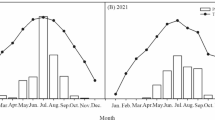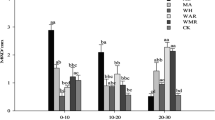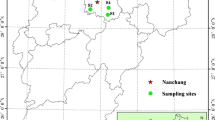Abstract
Purpose
Frequent cultivation and overhead irrigation have led to severe surface crusting, erosion and poor irrigation performance on sandy clay loam soils in the Coal River Valley, Tasmania, Australia. This study was established to identify the key soil properties related to aggregate breakdown determined by different methods, and explore options for reducing soil crusting.
Materials and methods
Soil aggregates were collected from 0 to 5 cm depth from 20 sites managed for packet salad and lettuce production. The stability of air-dried 2.00–4.75 mm aggregates was determined by rainfall simulation, wet sieving and clay dispersion. Soil aggregates were analysed for particle size, mineralogy, soluble and exchangeable cations, pH, EC, labile carbon and total carbon. The association between aggregate stability and the measured soil properties was explored using Spearman correlation, linear regression and regression tree analysis.
Result and discussion
Aggregate stability determined by rainfall simulation was closely associated with soil properties that promote aggregation, including effective cation exchangeable capacity (ECEC) and the proportion of polyvalent cations (Ca2+, Al3+). In contrast, aggregate stability determined by wet sieving was associated with soil properties that promote disaggregation, including quartz and sand content, and to lesser extent, the proportion of monovalent cations (especially K+). Clay dispersion was closely associated with pH, quartz content, soil texture and the sodium adsorption ratio. Soil carbon appeared to have only moderate influence on aggregate stability, but not clay dispersion, while labile carbon was not significantly related to any measure of aggregate stability or clay dispersion. Similarly, the proportion of Na+ ions was not related to either measure of aggregate stability and was only moderately related to clay dispersion.
Conclusions
Options for improving aggregate stability appear limited as aggregate stability was strongly related to the content of inherent soil properties such as sand/quartz and smectite contents. However, high correlation between exchangeable Ca2+ and aggregate stability determined by rainfall simulation indicates that soil crusting may be reduced through application of products that rich in Ca2+ such as gypsum.


Similar content being viewed by others
References
Ahmad N, Roblin AJ (1971) Crusting of River Estate soil, Trinidad, and its effect on gaseous diffusion, percolation, and seedling emergence. J Soil Sci 22:23–31
Amezketa E, Aragues R (1995) Hydraulic conductivity, dispersion and osmotic explosion in arid-zone soils leached with electrolyte solutions. Soil Sci 159:287–293
Auerswald K, Kainz M, Angermuller S, Steindl H (1996) Influence of exchangeable potassium on soil erodibility. Soil Use Manage 12:117–121
Baohua G, Doner HE (1993) Dispersion and aggregation of soils as influenced by organic and inorganic polymers. Soil Sci Soc Am J 57:709–716
Bazzoffi P, Mbagwu JSC, Chukwu WIE (1995) Statistical models for predicting aggregate stability from intrinsic soil components. Int Agrophys 9:1–9
Bennett JM, Greene RSB, Murphy BW, Hocking P, Tongway D (2014) Influence of lime and gypsum on long-term rehabilitation of a Red Sodosol, in a semi-arid environment of New South Wales. Soil Res 52:–120
Boix-Fayos C, Calvo-Cases A, Imeson AC, Soriano-Soto MD (2001) Influence of soil properties on the aggregation of some Mediterranean soils and the use of aggregate size and stability as land degradation indicators. Catena 44:47–67
Bureau of Meteorology (2014) Climate statistics for Australian locations: Hobart airport. Australian Bureau of Meteorology. http://www.bom.gov.au/climate/averages/tables/cw_094008.shtml
Carter MR (1992) Influence of reduced tillage systems on organic matter, microbial biomass, macro-aggregate distribution and structural stability of the surface soil in a humid climate. Soil Tillage Res 23:361–372
Chan KY, Heenan DP (1999) Lime-induced loss of soil organic carbon and effect on aggregate stability. Soil Sci Soc Am J 63:1841–1844
Chaney K, Swift RS (1984) The influence of organic matter on aggregate stability in some British soils. J Soil Sci 35:223–230
Chenu C, Guerif J (1991) Mechanical strength of clay minerals as influenced by an adsorbed polysaccharide. Soil Sci Soc Am J 55:1076–1080
Chenu C, Le Bissonnais Y, Arrouays D (2000) Organic matter influence on clay wettability and soil aggregate stability. Soil Sci Soc Am J 64:1479–1486
Duchicela J, Vogelsang KM, Schultz PA, Kaonongbua W, Middleton EL, Bever JD (2012) Non-native plants and soil microbes: potential contributors to the consistent reduction in soil aggregate stability caused by the disturbance of North American grasslands. New Phytol 196:212–222
Elliott ET (1986) Aggregate structure and carbon, nitrogen, and phosphorus in a semi-arid environment. Soil Sci Soc Am J 50:627–633
Fernandez-Ugalde O, Barre P, Hubert F, Virto I, Girardin C, Ferrage E, Caner L, Chenu C (2013) Clay mineralogy differs qualitatively in aggregate-size classes: clay-mineral-based evidence for aggregate hierarchy in temperate soils. Eur J Soil Sci 64:410–422
Ghani A, Dexter M, Perrott KW (2003) Hot-water extractable carbon in soils: a sensitive measurement for determining impacts of fertilisation, grazing and cultivation. Soil Biol Biochem 35:1231–1243
Hanay A, Büyüksönmez F, Kiziloglu FM, Canbolat MY (2004) Reclamation of saline-sodic soils with gypsum and MSW compost. Compost Sci Util 12:175–179
Hardie M, Doyle R, Cotching W, Holz G, Lisson S (2013) Hydropedology and preferential flow in the Tasmanian texture-contrast soils. Vadose Zone Journal 12(4). doi:10.2136/vzj2013.03.0051
Haynes RJ (1993) Effect of sample pretreatment on aggregate stability measured by wet sieving or turbidimetry on soils of different cropping history. J Soil Sci 44:261–270
Idowu OJ (2003) Relationships between aggregate stability and selected soil properties in humid tropical environment. Commun Soil Sci Plant Anal 34:695–708
Igwe CA, Okebalama CB (2006) Soil strength of some Central Eastern Nigeria soils and effect of potassium and sodium on their dispersion. International Agrophysics 20:107–112
Igwe CA, Zarei M, Stahr K (2009) Colloidal stability in some tropical soils of southeastern Nigeria as affected by iron and aluminium oxides. Catena 77:232–237
Kemper WD, Koch EJ (1966) Aggregate stability of soils from the western portions of the United States and Canada. U.S. Department of Agrigulture, Technical Bulletin, Washington, DC No. 1355
Lado M, Ben-Hur M (2004) Soil mineralogy effects on seal formation, runoff and soil loss. Appl Clay Sci 24:209–224
Laurenson S, Smith E, Bolan NS, McCarthy M (2011) Effect of K+ on Na-Ca exchange and the SAR-ESP relationship. Soil Res 49:538–546
Laws JO, Parsons DA (1943) The relation of raindrop-size to intensity. Am Geophys Union 24:452–460
Le Bissonnais Y (1996) Aggregate stability and assessment of soil crustability and erodibility: I. Theory and methodology. Eur J Soil Sci 47:425–437
Levy GJ, Feigenbaum S (1996) The distribution of potassium and sodium between the solution and the solid phase in a ternary (K-Na-Ca) system. Aust J Soil Res 34:749–754
Loveland P, Webb J (2003) Is there a critical level of organic matter in the agricultural soils of temperate regions: a review. Soil Till Res 70:1–18
Marchuk A, Marchuk S, Bennett J, Eyres M, Scott E (2014) An alternative index to ESP to explain dispersion occurring in Australian soils when Na content is low. National Soil Science Conference, Melbourne, Australia
Oades JM, Waters AG (1991) Aggregate hierarchy in soils. Aust J Soil Res 29:815–828
Portella CMR, Guimarães MF, Feller C, Fonseca ICB, Filho JT (2012) Soil aggregation under different management systems. Rev Bras Cienc Solo 36:1868–1977
Rayment G, Lyons D (2011) Soil chemical methods—Australasia. CSIRO Publishing, Collingwood, Victoria, Australia
Reichert JM, Norton LD, Favaretto N, Huang C, Blume E (2009) Settling velocity, aggregate stability, and interrill erodibility of soils varying in clay mineralogy. Soil Sci Soc Am J 73:1369
Rengasamy P (2010) Osmotic and ionic effects of various electrolytes on the growth of wheat. Aust J Soil Res 48:120–124
Rengasamy P, Marchuk A (2011) Cation ratio of soil structural stability (CROSS. Soil Research 49:280–285
Rengasamy P, Greene RSB, Ford GW, Mehanni AH (1984) Identification of dispersive behavior and the management of red-brown earths. Aust J Soil Res 22:413–431
Ross SM (1993) Organic matter in tropical soils: current conditions, concerns and prospects for conservation. Prog Phys Geogr 17:265–305
Roth CH, Eggert T (1994) Mechanisms of aggregate breakdown involved in surface sealing, runoff generation and sediment concentration on loess soils. Soil Till Res 32:253–268
SAS Institute (2014) JMP online documentation: partition models. http://www.jmp.com/support/help/Partition_Models.shtml
Shainberg I, Letey J (1984) Response of soils to sodic saline conditions. Hilgardia 52:1–57
Singer A (1994) Clay mineralogy as affecting dispersivity and crust formation in aridisols. In: 15th World Congress of Soil Science, vol 8A. Transactions: Commission Vii: Symposia, pp 37–46
Six J, Elliott ET, Paustian K (1999) Aggregate and soil organic matter dynamics under conventional and no-tillage systems. Soil Sci Soc Am J 63:1350–1358
Six J, Elliott ET, Paustian K (2000) Soil structure and soil organic matter: II. A normalized stability index and the effect of mineralogy. Soil Sci Soc Am J 64:1042–1049
Stern R, Benhur M, Shainberg I (1991) Clay mineralogy effect on rain infiltration, seal formation and soil losses. Soil Sci 152:455–462
Tisdall JM, Oades JM (1982) Organic matter and water-stable aggregates. J Soil Sci 33:141–163
Voelkner A, Holthusen D, Horn R (2015) Determination of soil dispersion caused by anaerobic digestates: interferences of pH and soil charge with regard to soil texture and water content. J Soils Sediments 15:1491–1499
Wakindiki IIC, Ben-Hur M (2002) Soil mineralogy and texture effects on crust micromorphology, infiltration, and erosion. Soil Sci Soc Am J 66:897–905
Walkley A, Black IA (1934) An examination of the Degtjareff method for determining soil organic matter, and a proposed modification of the chromic acid titration method. Soil Sci 37:29–38
Wuddivira MN, Camps-Roach G (2007) Effects of organic matter and calcium on soil structural stability. Eur J Soil Sci 58:722–727
Acknowledgments
This research was supported by School of Land and Food, Tasmania Institute of Agriculture, University of Tasmania, Houston’ Farm and Iraqi Government. We thank the team at Houston’s farm (Ricky and Claire) for assistance with fieldwork and site selection; we wish to thank Garth Oliver for assistance with lab work and Ross Corkrey for assistance with statistical analysis.
Author information
Authors and Affiliations
Corresponding author
Additional information
Responsible editor: Saulo Rodrigues-Filho
Rights and permissions
About this article
Cite this article
Almajmaie, A., Hardie, M., Doyle, R. et al. Influence of soil properties on the aggregate stability of cultivated sandy clay loams. J Soils Sediments 17, 800–809 (2017). https://doi.org/10.1007/s11368-016-1568-1
Received:
Accepted:
Published:
Issue Date:
DOI: https://doi.org/10.1007/s11368-016-1568-1




